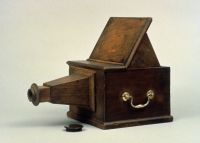
Up Next: Jefferson's "Sanctum Sanctorum"
In the late evening, Jefferson retired to his private suite of rooms where he pursued any of several activities, ranging from architecture and astronomy to the more mundane.

From the West Lawn, Thomas Jefferson, family, and guests could walk up the stairs on the West Portico to reach the Parlor, one of three rooms in Monticello that were part of Jefferson's original plan for the home in 1769. The Parlor was a public room, designed for conversation, music, games, and reading.
Jefferson wrote that music "furnishes a delightful recreation for the hours of respite from the cares of the day, and lasts us through life." The Parlor was the site for many of these hours of "delightful recreation." Jefferson himself played violin, and his wife, daughters, and granddaughters played several instruments, including the pianoforte, harpsichord, and guitar. Jefferson's namesake grandson, Thomas Jefferson Randolph, recalled that before his grandfather "lost his taste for the violin, he would play on it, having his grandchildren dancing around him."
 The Parlor held folding tables for games, such as a chess set that according to family tradition was a gift from the French court to Jefferson, an avid player. Another amusement was the camera obscura, a predecessor to the modern camera, which was used by the grandchildren as an aid in drawing and possibly in making silhouettes.
The Parlor held folding tables for games, such as a chess set that according to family tradition was a gift from the French court to Jefferson, an avid player. Another amusement was the camera obscura, a predecessor to the modern camera, which was used by the grandchildren as an aid in drawing and possibly in making silhouettes.
On quieter evenings, the family gathered to read. Jefferson's granddaughter Virginia Randolph Trist wrote: "When the candles were brought, all was quiet immediately, for he took up his book to read; and we would not speak out of a whisper, lest we should disturb him, and generally we followed his example and took a book; and I have seen him raise his eyes from his own book, and look round on the little circle of readers and smile."
The Parlor was the site of celebrations, as well, including weddings and christenings. The walls were, according to one guest, "hung with pictures from floor to ceiling." Among the more than fifty paintings in the Parlor were copies of Old Master classics and portraits of significant figures from history. In addition, the floor was made of a parquet design in beech and cherry, one of the first of its kind in America. Among the most remarkable features of the room -- then and now -- are the single-acting double doors. When either of the glass doors is opened or closed, the other follows in a mirror-like fashion.

To accommodate guests and family, there were a large number and variety of chairs, ranging from sofas that doubled as sleeping quarters for overnight guests to campeachy chairs. Jefferson admired the campeachy, or "siesta," chairs (pictured at left) because "Age, its infirmities and frequent illnesses have rendered indulgence in that easy kind of chair truly acceptable." Granddaughter Ellen recalled seeing Jefferson in the campeachy chair, "where, in the shady twilight, I was used to see him resting."

In the late evening, Jefferson retired to his private suite of rooms where he pursued any of several activities, ranging from architecture and astronomy to the more mundane.
ADDRESS:
1050 Monticello Loop
Charlottesville, VA 22902
GENERAL INFORMATION:
(434) 984-9800